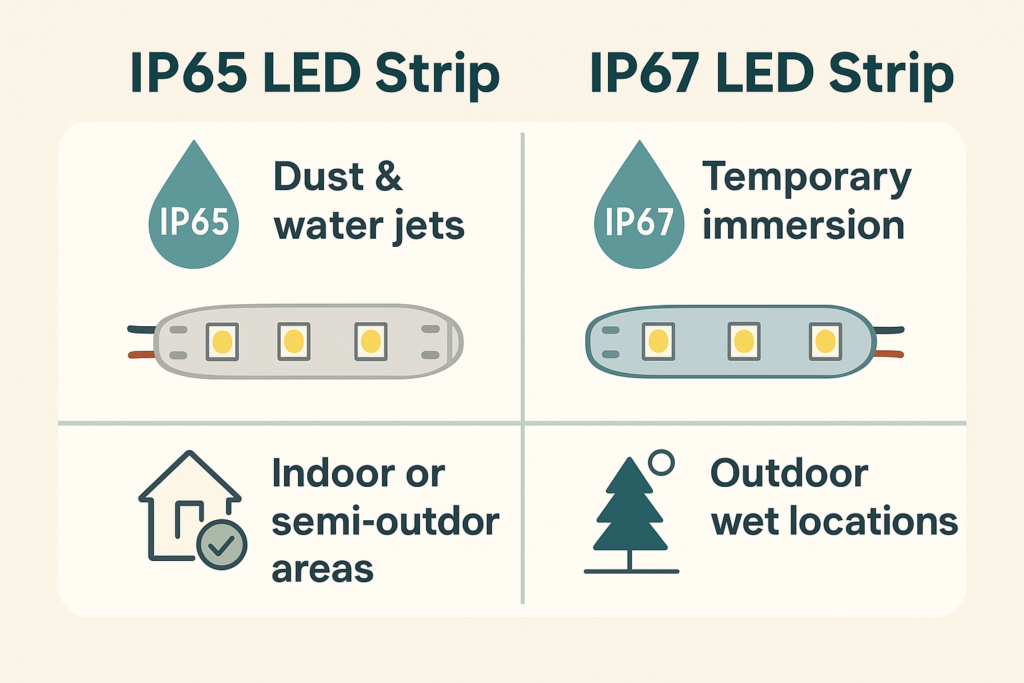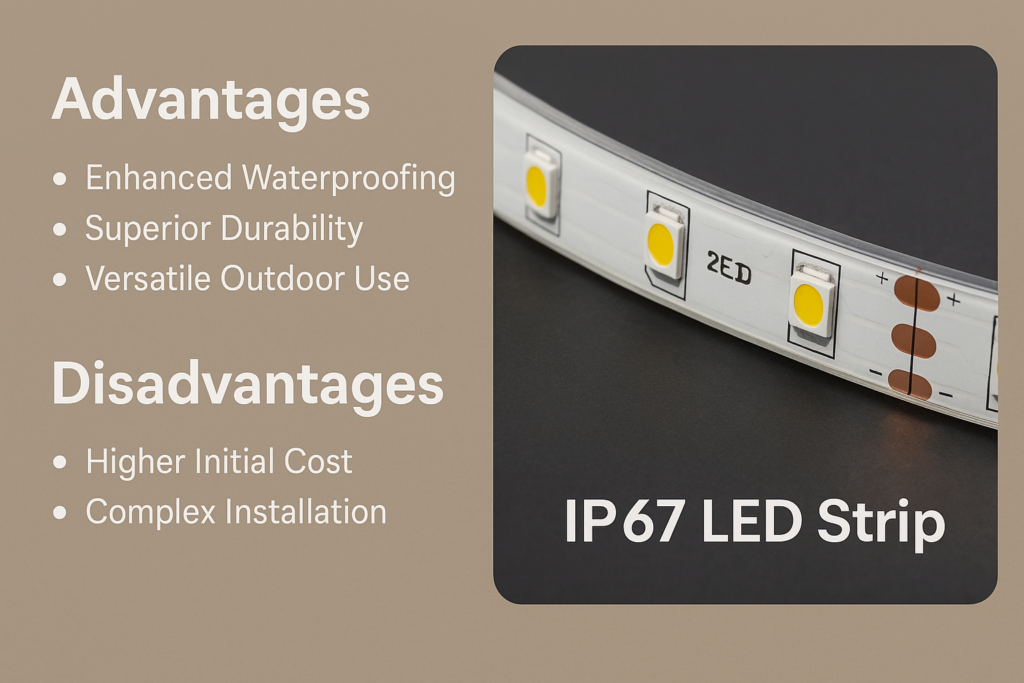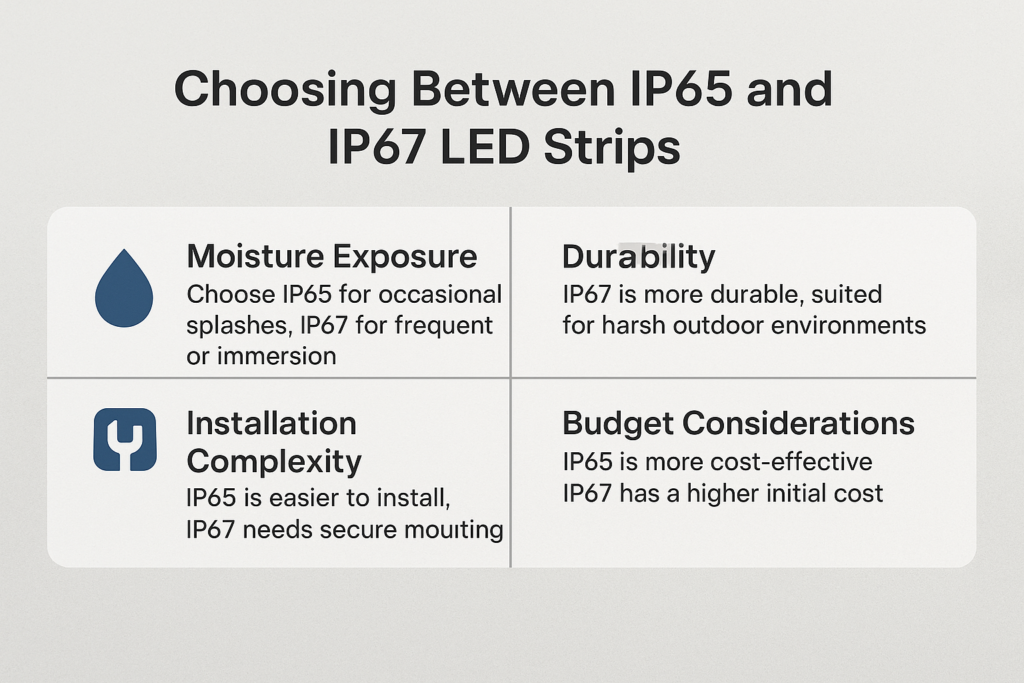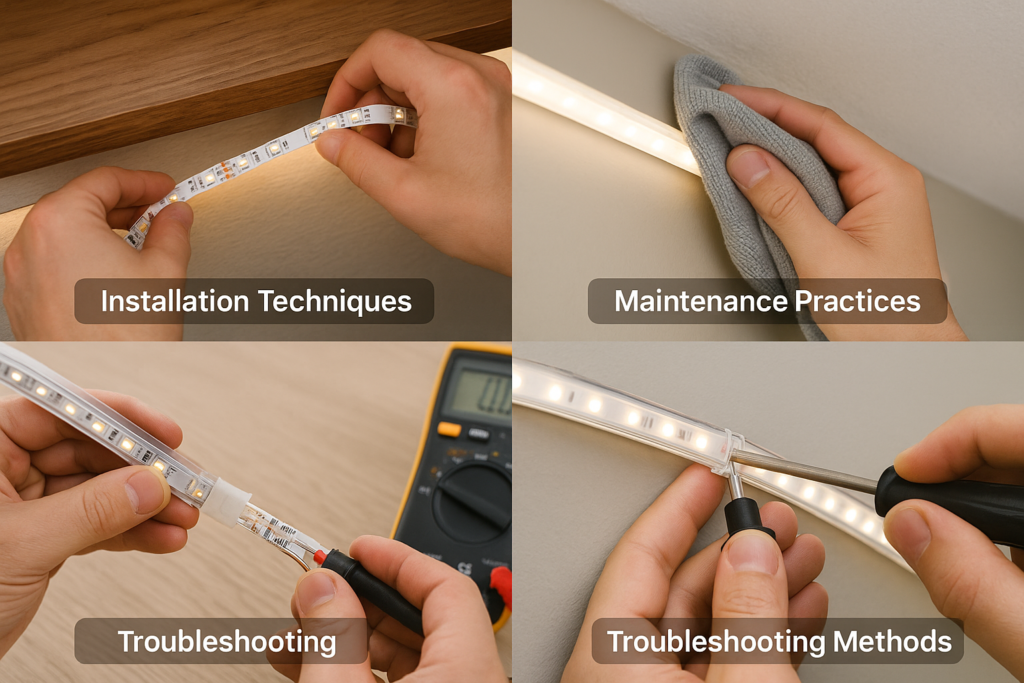“IP65 LED strips provide reliable moisture protection, ideal for indoor and partially covered outdoor installations. IP67 LED strips offer enhanced waterproofing, suitable for fully exposed outdoor environments. Clearly understanding their differences helps you choose the ideal lighting solution.”
Introduction to IP65 and IP67 LED Strips
Having personally installed various types of waterproof LED lighting, I clearly understand the differences between IP65 and IP67 LED strips. Here’s a straightforward introduction to help you choose the ideal solution for your specific needs.
What Are IP65 LED Strips?
IP65 LED strips offer strong protection against dust and are resistant to water jets, making them suitable for indoor spaces or partially covered outdoor installations. They’re clearly ideal for kitchens, bathrooms, and covered patios, where moisture protection is necessary but full immersion or prolonged exposure isn’t expected.
What Are IP67 LED Strips?
IP67 LED strips provide higher waterproof protection, including temporary immersion in water. Clearly more durable, they are designed specifically for fully exposed outdoor environments or damp locations, such as poolside installations, outdoor signage, or areas frequently exposed to rain and moisture.
Clients often ask me, “What’s the main difference between IP65 and IP67 LED strips?” Clearly, IP65 strips offer moderate moisture resistance suitable for semi-exposed installations, while IP67 strips provide superior waterproofing clearly suited for fully exposed and demanding outdoor environments.

Technical Differences Clearly Explained
From my hands-on experience installing IP65 and IP67 LED strips, I clearly understand their technical differences. Here’s a straightforward comparison to guide you in making the right choice.
Waterproofing & Moisture Protection
- IP65 LED Strips:
Provide strong resistance to dust and protection from low-pressure water jets, clearly suitable for indoor or partially sheltered outdoor installations.
- IP67 LED Strips:
Offer higher waterproofing capabilities, clearly allowing temporary immersion in water and excellent resistance in fully exposed outdoor environments.
Durability & Environmental Resistance
- IP65 LED Strips:
Good durability clearly sufficient for moderate moisture environments, but not recommended for fully exposed or highly damp areas.
- IP67 LED Strips:
Clearly superior in durability, providing reliable performance in outdoor conditions, frequent rain, or poolside applications.
Installation Complexity & Practical Considerations
- IP65 LED Strips:
Generally straightforward installation, clearly easy handling, suitable for DIY setups or semi-outdoor use.
- IP67 LED Strips:
Require slightly more complex installation due to enhanced waterproof sealing and handling requirements, clearly suited for professional installation or detailed planning.
Clients frequently ask me, “Which is better for outdoor lighting—IP65 or IP67?” Clearly, IP67 LED strips are the superior choice for fully exposed outdoor areas requiring enhanced waterproof protection.
Comparison Table:
| Feature |
IP65 LED Strips |
IP67 LED Strips |
| Waterproofing |
Dust & water jets (no immersion) |
Temporary water immersion |
| Durabilidad |
Moderate, suitable for indoors |
High, excellent for outdoors |
| Complejidad de la instalación |
Simple |
Slightly more complex |
| Ideal Applications |
Indoor, semi-outdoor |
Outdoor, wet environments |
| Coste |
Cost-effective |
Moderate to higher initial cost |
Advantages and Disadvantages of IP65 LED Strips
Having personally installed IP65 LED strips in various indoor and semi-outdoor environments, I clearly understand their practical strengths and limitations. Here’s a clear breakdown to guide your selection effectively:
Advantages of IP65 LED Strips
- Cost-Effective:
Clearly more affordable and suitable for budget-conscious projects requiring basic waterproofing.
- Moderate Moisture Protection:
Effective against dust and water jets, clearly ideal for kitchens, bathrooms, and covered outdoor installations.
- Easy Installation:
Simple and straightforward installation clearly suitable for DIY projects and general decorative lighting setups.
Disadvantages of IP65 LED Strips
- Limited Outdoor Durability:
Clearly less suitable for fully exposed outdoor applications or prolonged moisture exposure.
- Not Suitable for Immersion:
Clearly unable to withstand direct immersion in water, limiting their use near pools or water features.
Clients frequently ask me, “Can IP65 LED strips withstand rain?” Clearly, IP65 strips can handle occasional splashes and moderate moisture but aren’t ideal for continuous outdoor exposure to heavy rain or immersion.

Advantages and Disadvantages of IP67 LED Strips
Having personally installed IP67 LED strips in various challenging outdoor environments, I clearly understand their specific strengths and practical limitations. Here’s a straightforward overview to guide your selection effectively:
Advantages of IP67 LED Strips
- Enhanced Waterproofing:
Clearly suitable for temporary immersion and continuous exposure to moisture, ideal for outdoor, wet environments like poolsides or outdoor signage.
- Superior Durability:
Highly resistant to water and dust, offering reliable performance in harsh conditions and clearly ideal for long-term outdoor installations.
- Versatile Outdoor Use:
Excellent choice for exposed areas where robust weather protection is necessary, providing clear peace of mind for outdoor projects.
Disadvantages of IP67 LED Strips
- Higher Initial Cost:
Generally more expensive upfront due to enhanced waterproofing and materials, clearly a factor to consider for budget-sensitive projects.
- Increased Installation Complexity:
Clearly requires careful handling, specialized mounting methods, and thorough sealing practices, often needing professional installation or detailed preparation.
Clients frequently ask me, “Are IP67 LED strips worth the additional investment?” Clearly, if your project involves regular outdoor exposure, harsh environmental conditions, or potential moisture contact, IP67 LED strips are definitely worth the extra cost and installation considerations.

Best Applications & Practical Scenarios
Having personally installed both IP65 and IP67 LED strips in numerous settings, I clearly understand the practical applications best suited for each type. Here’s straightforward advice to guide your selection:
Ideal Uses for IP65 LED Strips
IP65 LED strips clearly perform best in scenarios with moderate moisture exposure and indoor or semi-outdoor applications, including:
- Kitchens & Bathrooms:
Ideal for under-cabinet lighting, providing clear, effective moisture protection.
- Covered Patios & Decks:
Suitable for sheltered outdoor spaces clearly needing weather-resistant decorative lighting.
- General Indoor Decorative Lighting:
Excellent for living areas, accent lighting, and decorative features clearly protected from direct water contact.
Ideal Uses for IP67 LED Strips
IP67 LED strips clearly excel in fully exposed outdoor environments and areas with frequent moisture exposure, such as:
- Outdoor Signage & Architectural Highlights:
Clearly suitable for exposed outdoor lighting where superior waterproofing and durability are necessary.
- Pools & Water Features:
Ideal for installations near pools, fountains, and water features clearly requiring robust moisture resistance and occasional immersion protection.
- Harsh Environmental Conditions:
Perfect for outdoor decorative or functional lighting clearly exposed to rain, snow, or other environmental elements.
Clients often ask me, “Which is better for outdoor lighting, IP65 or IP67?” Clearly, IP67 is the superior choice for fully exposed outdoor environments and installations near water, while IP65 is sufficient for semi-covered or indoor moisture-prone areas.

How to Choose Between IP65 and IP67 LED Strips
Having personally installed IP65 and IP67 LED strips in diverse conditions, I clearly understand how crucial the selection is for achieving reliable lighting. Here’s straightforward guidance to help you confidently choose the ideal waterproof LED strip for your project.
Key Decision Factors
- Exposure to Moisture:
Clearly evaluate your installation environment. Choose IP65 for indoor or semi-covered areas exposed to occasional splashes. Select IP67 if your installation is outdoors or subject to frequent moisture, rain, or potential water immersion.
- Durability & Outdoor Conditions:
IP67 clearly offers higher durability and protection, ideal for harsh outdoor environments. IP65 is adequate for moderate indoor or sheltered outdoor spaces.
- Complejidad de la instalación:
IP65 LED strips offer straightforward installation suitable for DIY projects. IP67 LED strips require more detailed planning, secure mounting, and careful sealing clearly suitable for professional or detailed installations.
- Budget Considerations:
IP65 is generally more cost-effective. Clearly define your budget—IP67 offers enhanced durability and protection but at a slightly higher initial cost.
Common Mistakes & Practical Recommendations
- Misjudging Waterproof Needs:
Clearly avoid underestimating moisture exposure. Choose IP67 clearly if your project involves prolonged outdoor exposure or potential water contact.
- Overlooking Installation Requirements:
IP67 strips require additional sealing and careful installation. Clearly plan for these extra requirements to avoid potential issues.
- Choosing Solely Based on Price:
Clearly consider environmental conditions and long-term durability, rather than focusing only on initial purchase price.
Clients often ask me, “Is IP67 always better than IP65?” Clearly, IP67 is superior for fully exposed outdoor or wet environments, while IP65 is suitable for indoor or sheltered outdoor installations.
External Link:
IP65 vs IP67 LED Strip Lights – LEDSupply

Installation, Maintenance & Expert Recommendations
Having installed both IP65 and IP67 LED strips in various environments, I clearly understand key considerations for proper installation, maintenance, and troubleshooting. Here’s clear, practical guidance drawn from real-world experience to help ensure long-lasting performance.
Installation Recommendations
- IP65 LED Strips:
IP65 strips require minimal preparation—simply ensure a clean, dry surface, use adhesive backing or mounting clips, and connect securely to an appropriate power source and controller.
- IP67 LED Strips:
IP67 installations require careful sealing and secure mounting due to their enhanced waterproofing. Clearly ensure proper connectors, waterproof fittings, and secure mounting channels for reliable outdoor installation.
Essential Maintenance Advice
- Routine Inspections:
Regularly inspect LED strips for secure connections, consistent brightness, and potential damage, clearly important in outdoor environments.
- Effective Cleaning:
Gently clean IP65 and IP67 LED strips with a soft cloth occasionally, clearly maintaining brightness and visual appearance.
- Proper Sealing (IP67 Strips):
Regularly check waterproof sealing and connectors clearly to maintain effective water resistance and outdoor durability.
Solución de problemas comunes
- Inconsistent Brightness or Flickering:
Check power supply adequacy, connectors, and wiring clearly to resolve any brightness issues promptly.
- Water Ingress (IP67 Strips):
Regularly inspect waterproof seals and connectors, clearly resealing or replacing damaged sections as necessary.
- Installation Adhesion Issues:
Clearly ensure proper surface preparation. Consider using additional mounting methods like clips or channels clearly for added stability, especially outdoors.
Clients frequently ask me, “What issues commonly arise during installation of IP65 and IP67 LED strips?” Clearly, typical issues include inadequate sealing, improper wiring, insufficient power supply planning, and poor surface preparation.

FAQs About IP65 and IP67 LED Strips
Having installed IP65 and IP67 LED strips extensively, I clearly understand common questions users have. Here are straightforward answers to guide your selection process effectively.
What is the difference between IP65 and IP67 LED strips?
The main difference clearly lies in their waterproof ratings. IP65 LED strips offer protection from dust and water jets, suitable for indoor or semi-outdoor environments. IP67 LED strips provide superior protection, including temporary water immersion, ideal for fully exposed outdoor installations.
Which is better for outdoor use, IP65 or IP67?
Clearly, IP67 LED strips are better for outdoor applications, offering enhanced durability and superior moisture resistance compared to IP65, especially in areas exposed directly to weather.
Can IP65 LED strips withstand rain?
IP65 LED strips can withstand occasional splashes and moderate exposure to rain clearly, but for consistent or heavy exposure, IP67 strips are clearly the better choice.
Conclusion & Next Steps
Clearly understanding the differences between IP65 and IP67 LED strips enables you to confidently choose the ideal lighting solution for your project. From my experience, IP65 LED strips are perfect for indoor and semi-covered outdoor areas, providing effective moisture protection at a reasonable cost. IP67 LED strips clearly offer superior waterproofing and durability, ideal for fully exposed outdoor installations or areas frequently exposed to moisture.
Evaluate your project’s environmental conditions, durability requirements, installation complexity, and budget clearly to select the optimal LED strip type for your specific needs.
Ready to find the perfect LED lighting solution?
Explore Elstar’s LED Lighting Solutions →







